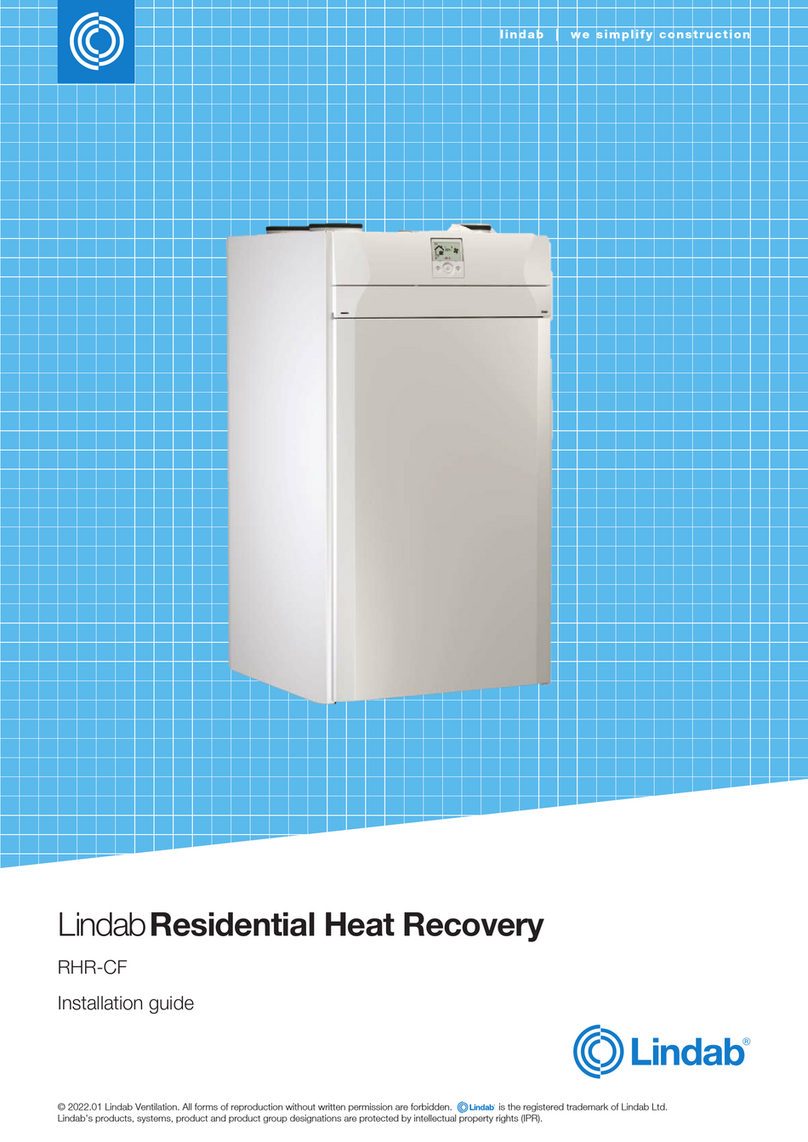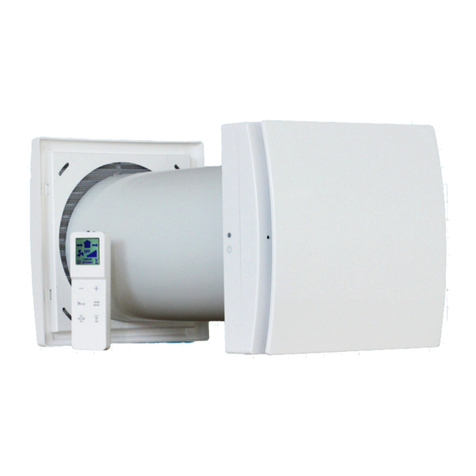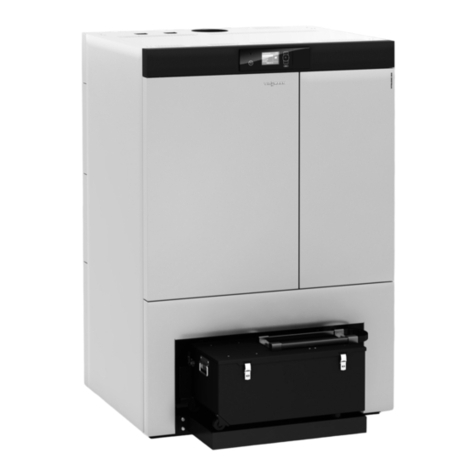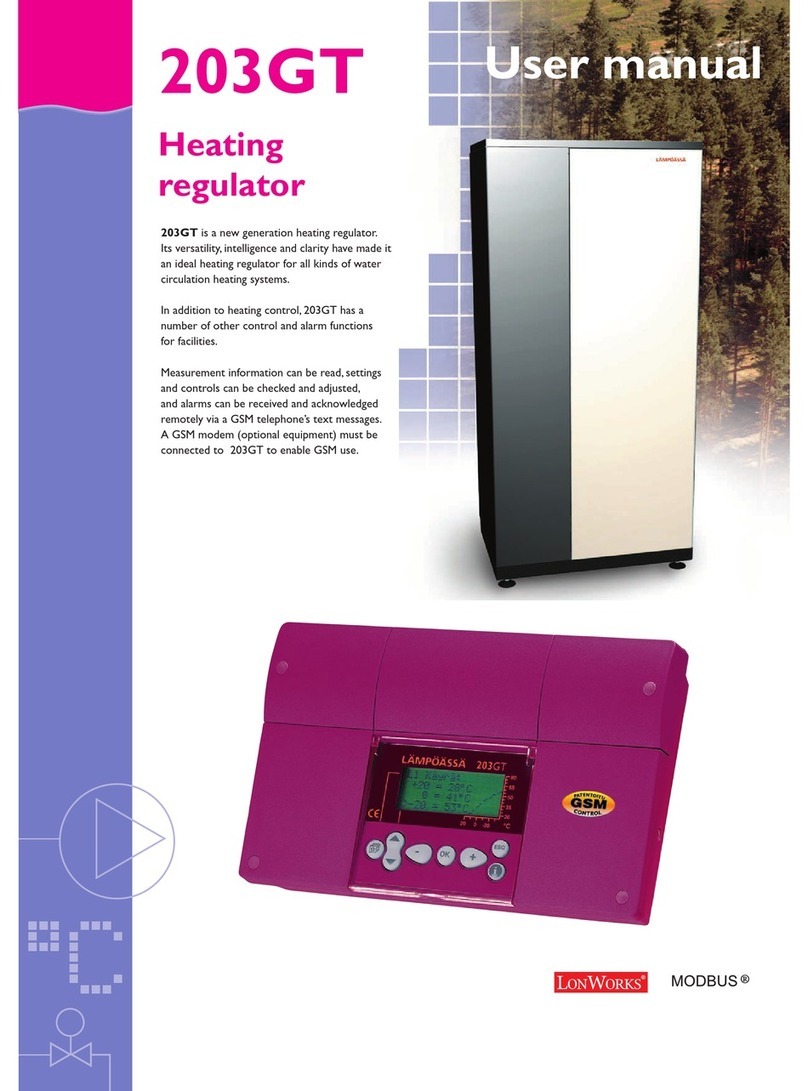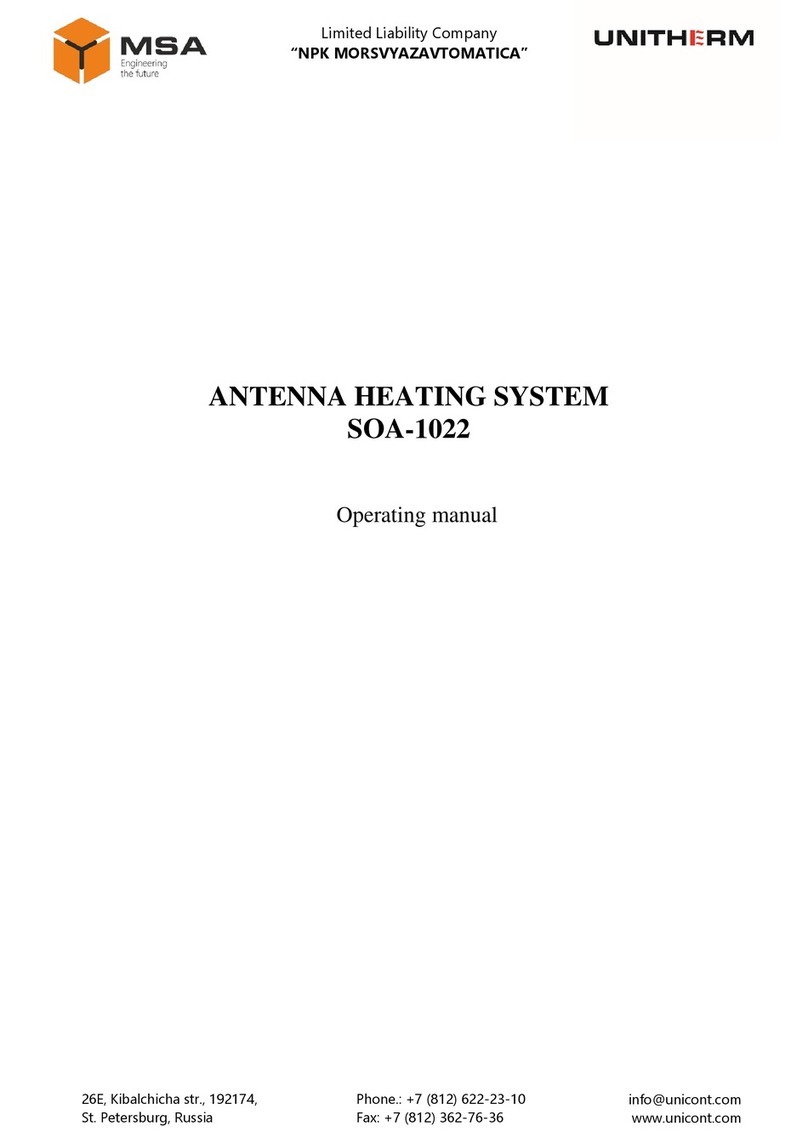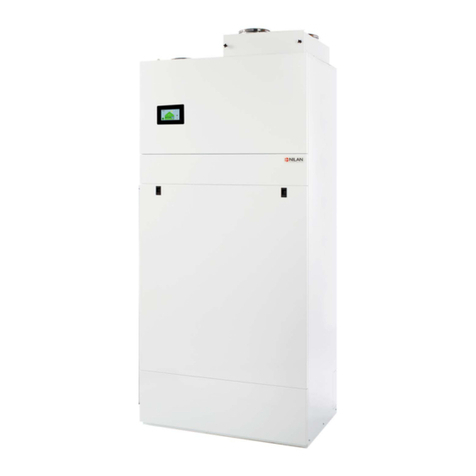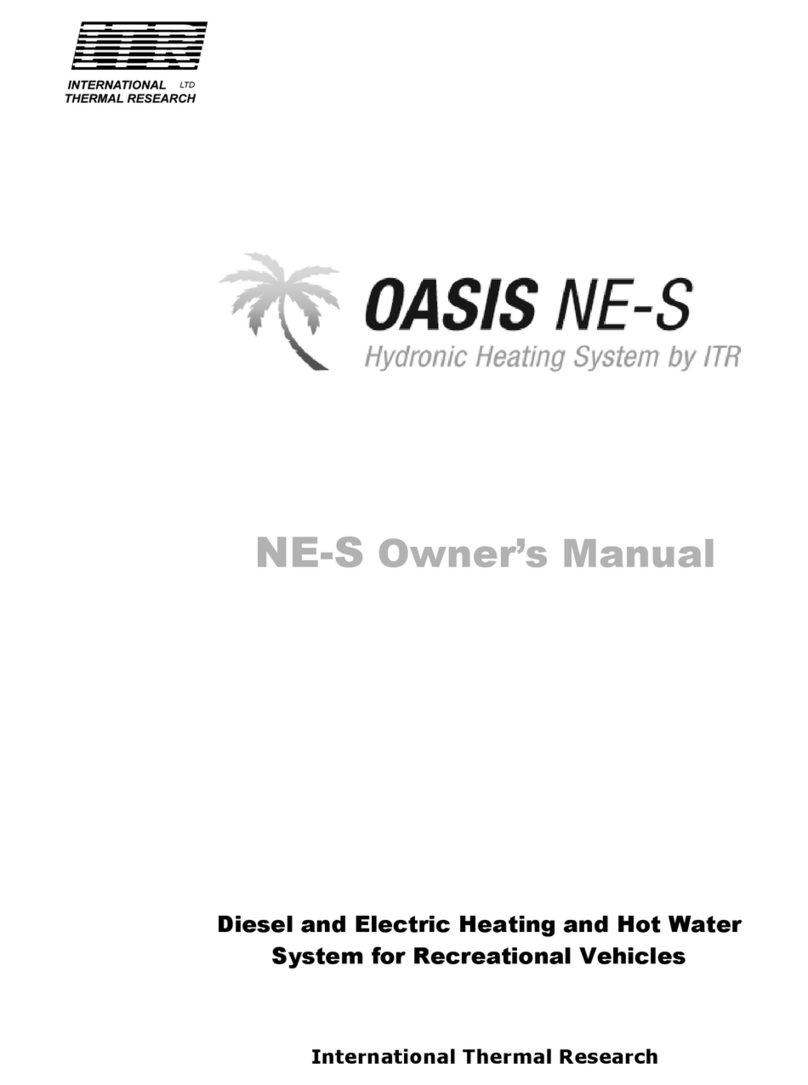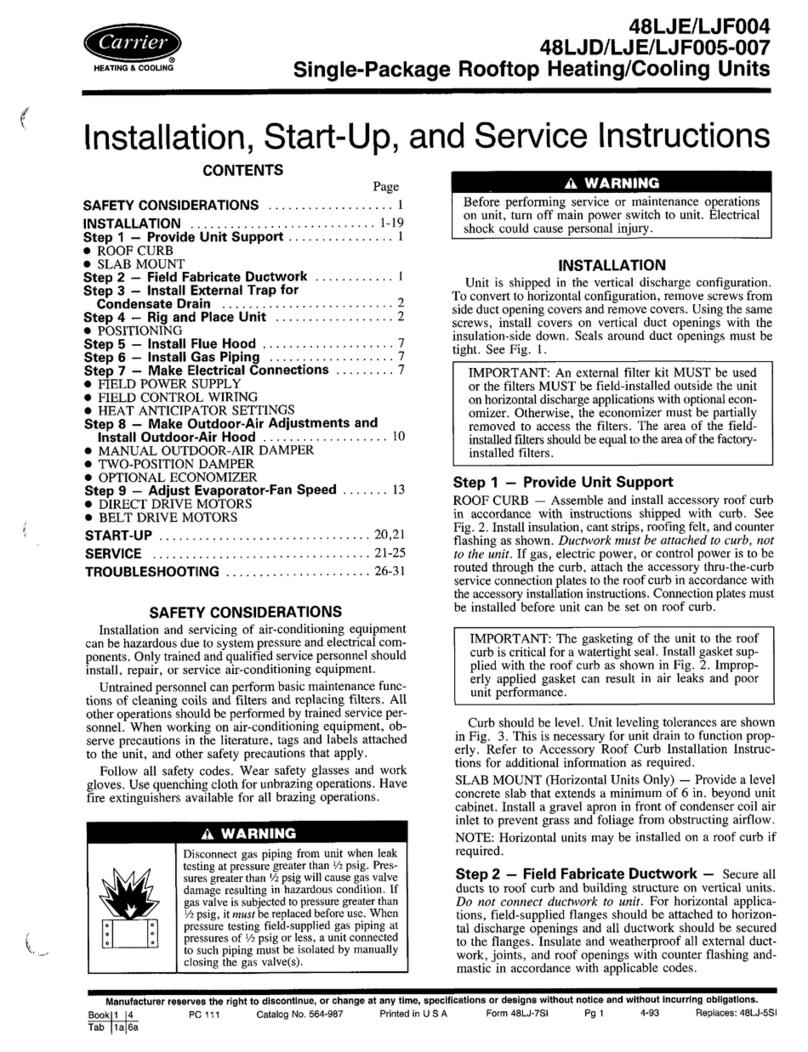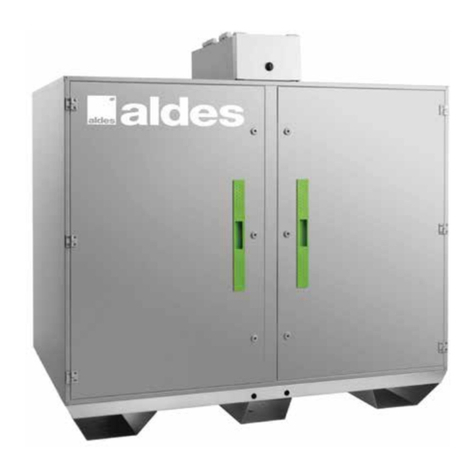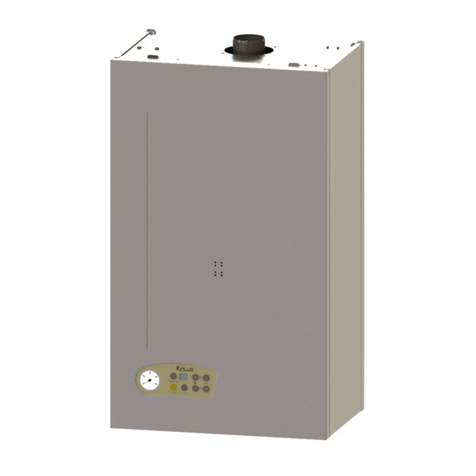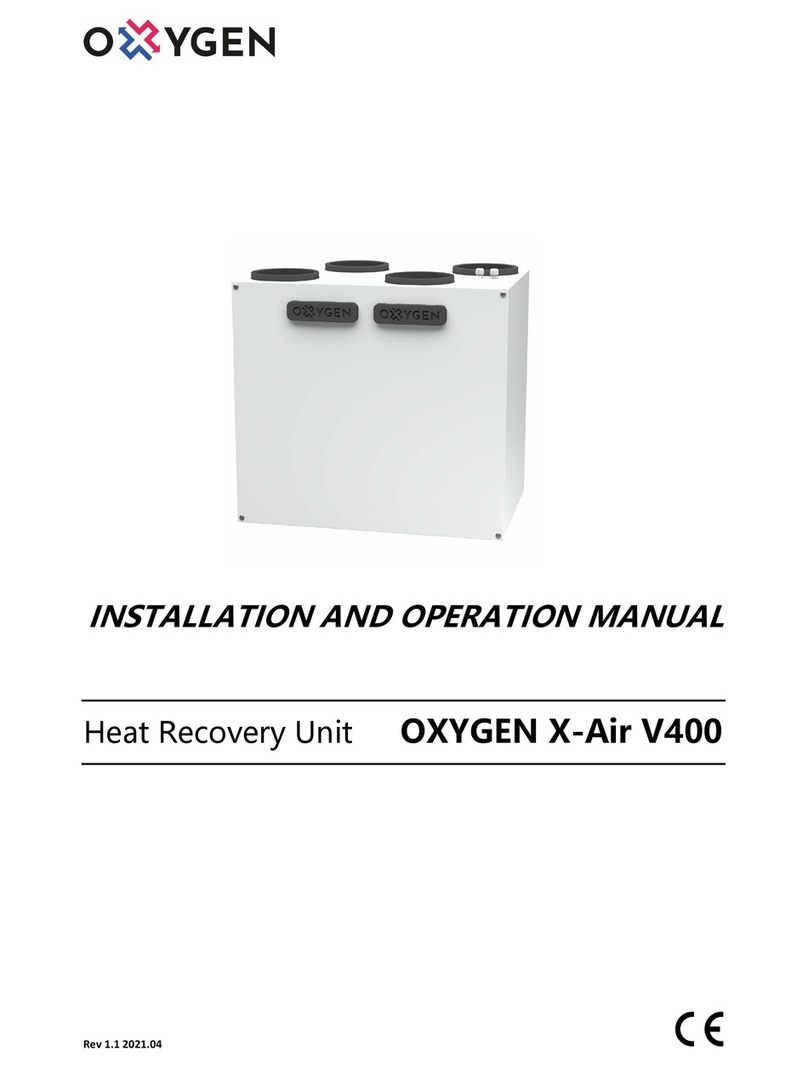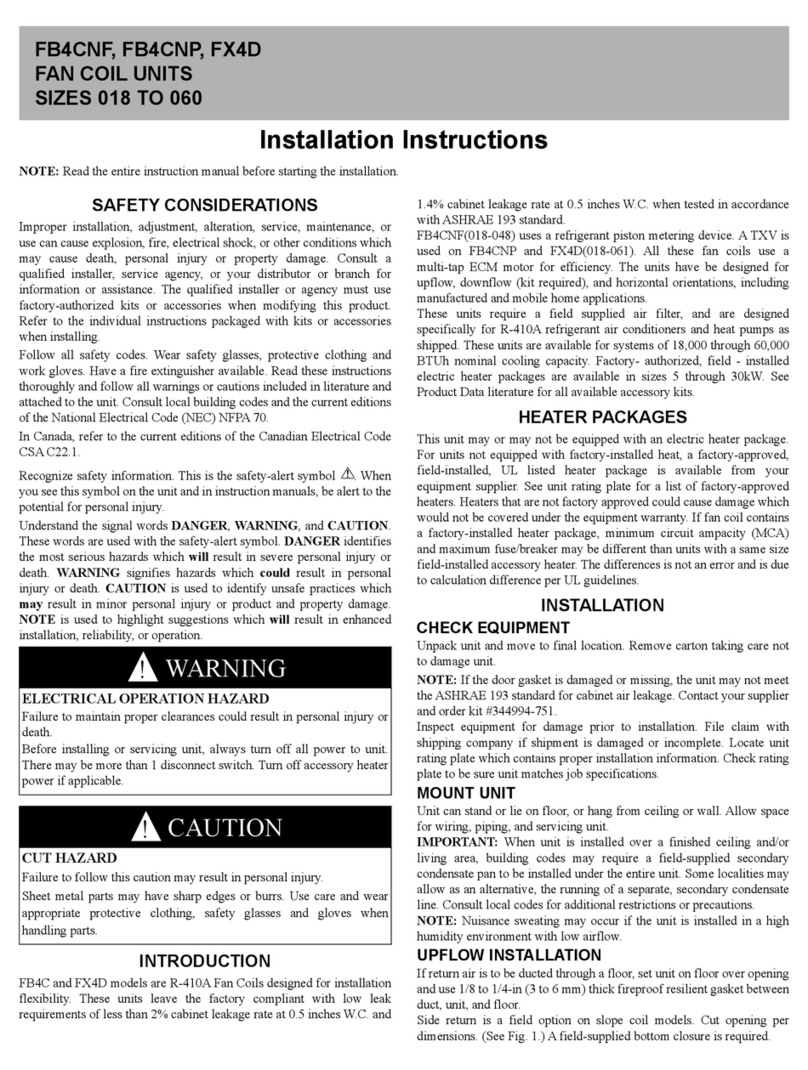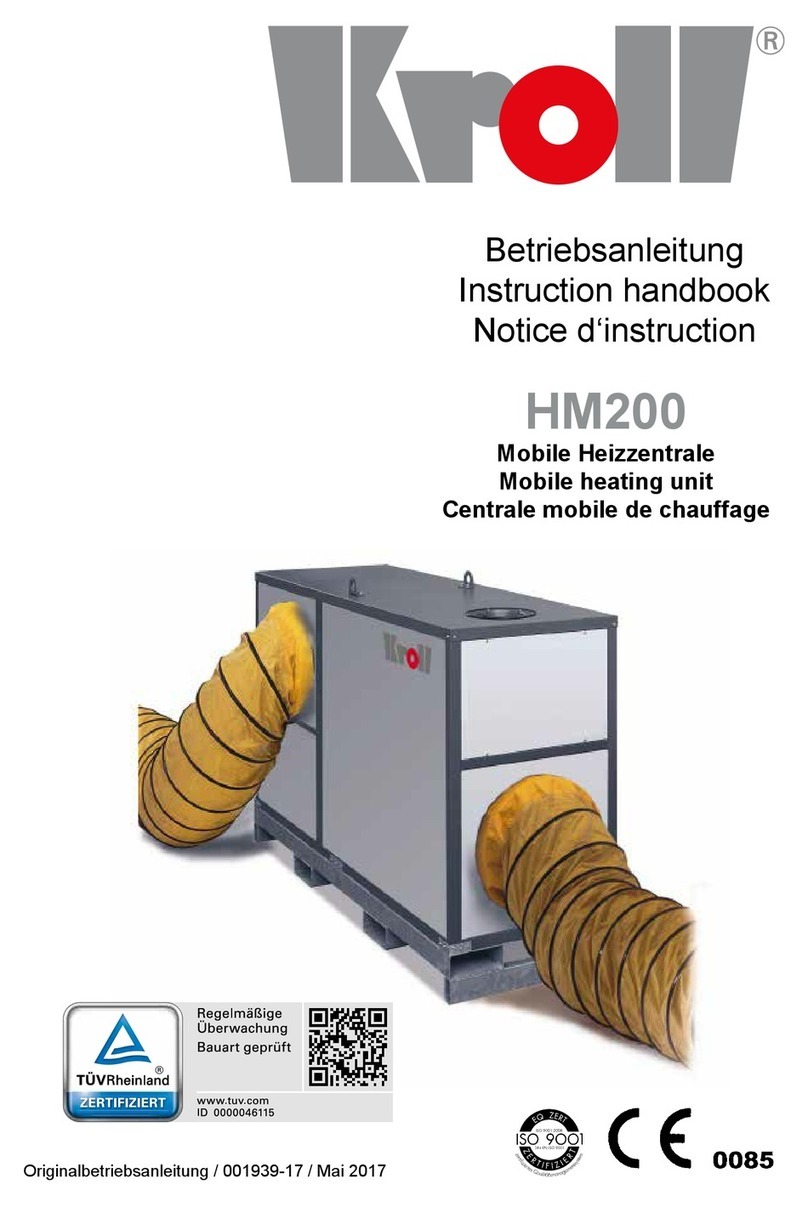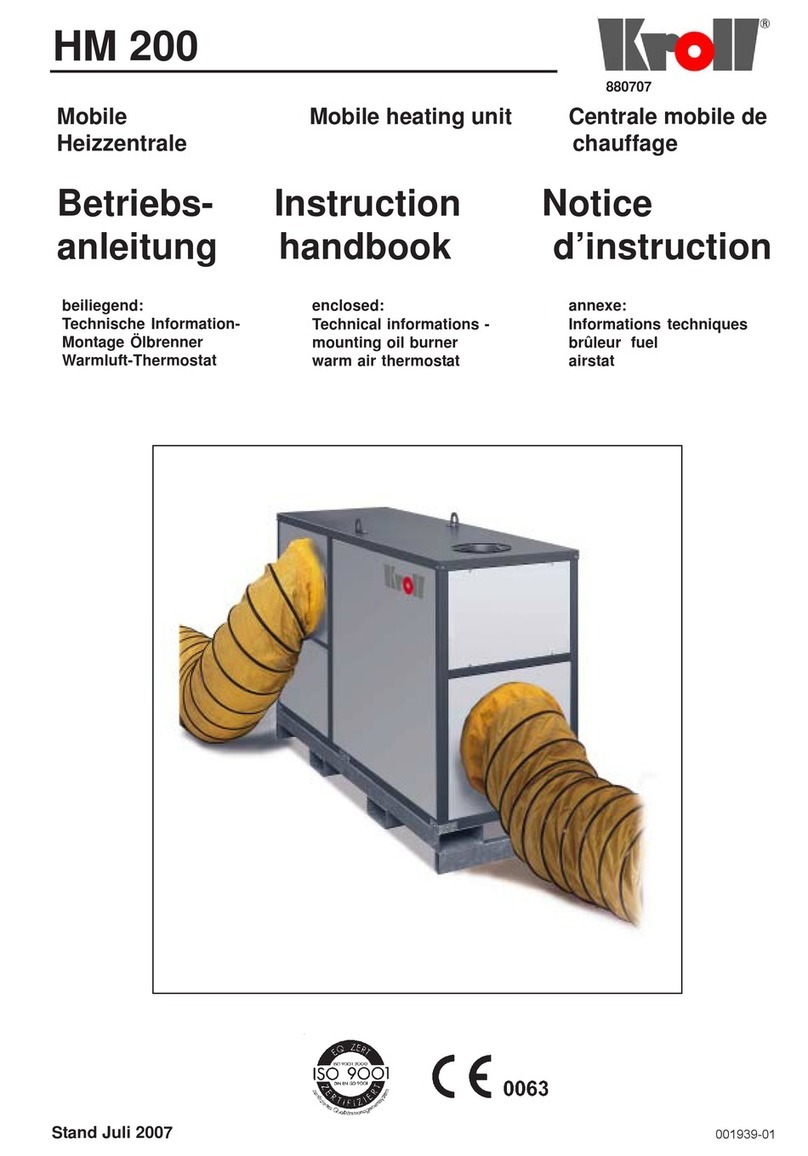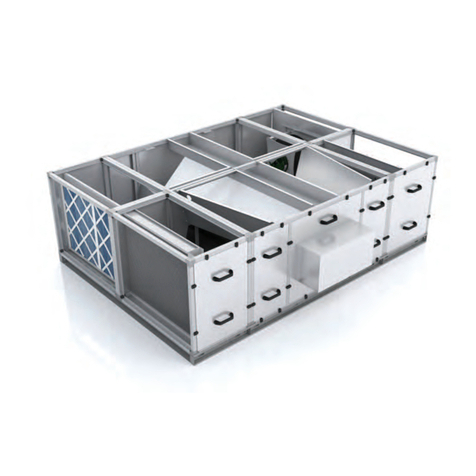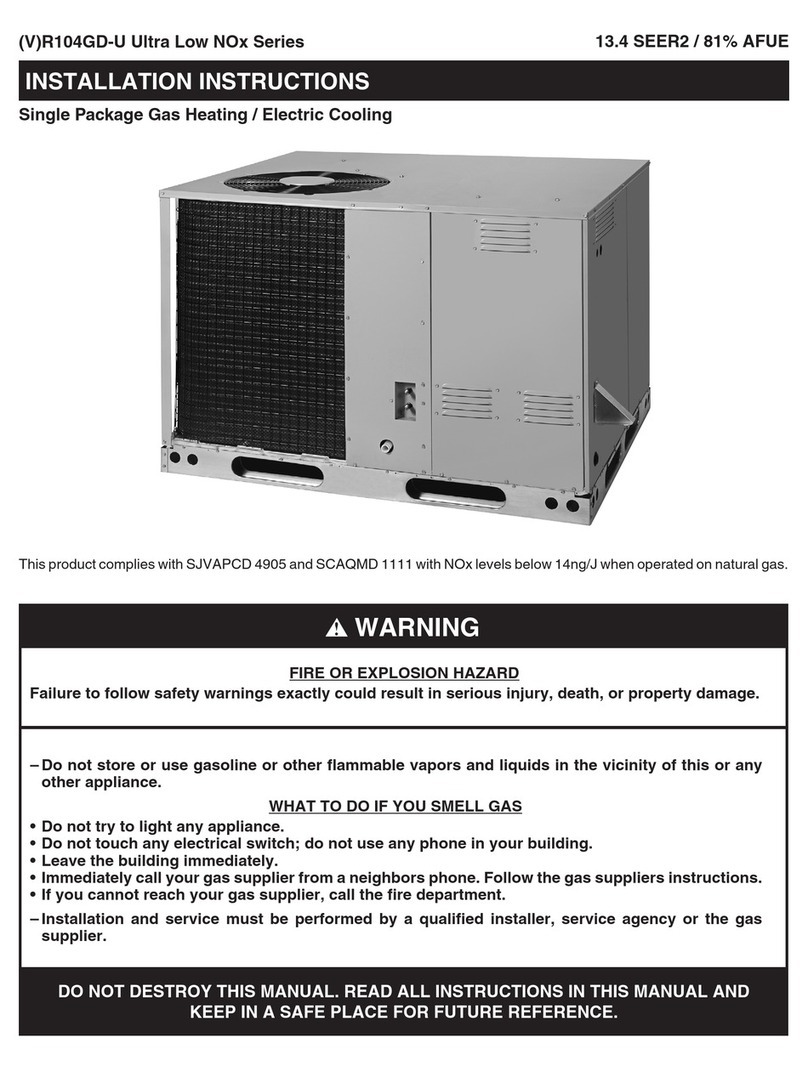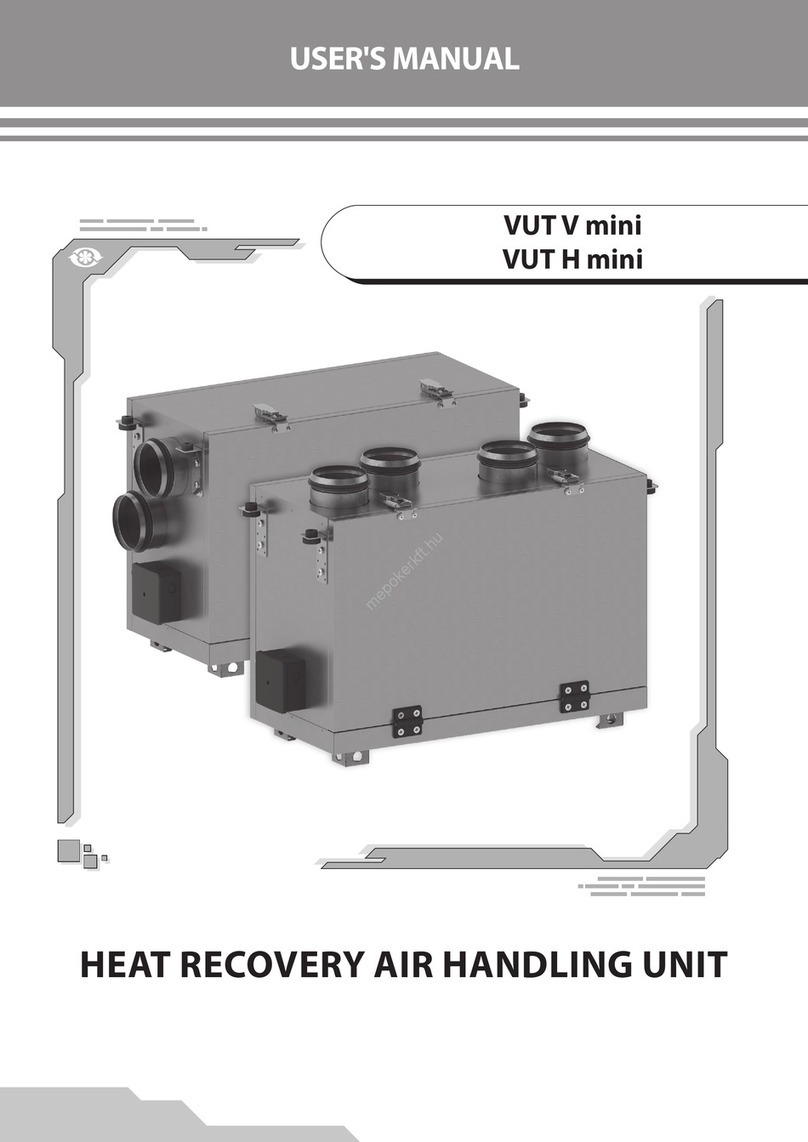Lindab RHR-CF Instruction manual

Lindab Residential
Heat Recovery
Counterflow Unit
RHR- CF
Quick user guide

Contents
Benefits of MVHR ………………………………………………………………………….. 3
User modes ……………………………………………………………………………….... 4
Inside the unit ……………………………………………………………………………..... 5
General site installation ……………………………………………………………….... 6-8
Unit maintenance ………………………………………………………………………. 9-10
Unit alarms/ faults ………………………………………………….............................… 11
Installation guidelines …………………………………………………….………..… 12-18
2

Benefits of MVHR
3
A Mechanical Ventilation Heat Recovery (MVHR) unit is designed to extract the humid / stale
air from wet rooms in your property-kitchen, WC, bathrooms, utility room etc. The heat from
these rooms is used to heat up the heat exchanger within the unit, which in turn heats up the
incoming supply air from outside and supplying this back to habitable rooms-living room,
bedrooms etc. Providing your property with warm fresh air.
RHR units are equipped with a summer bypass function, for when its beneficial to use the
fresh air for comfort cooling. If the supply air coming in to the property is cooler than the
extracted air the bypass will activate and create a sensation of cooling within the property.

User modes
4
Party Mode
A timed function, active for 3 hours after activation, in which the nominal speed is
increased by 30%. When this function is active on the main screen, the icon will also be
active. The 30% boost is used to offset the increased CO2 and Humidity levels created by
increased occupancy.
Holiday mode
An anti-mould function with the fans at minimum speed. When this function is active on
the main screen, the icon will also be active. To be activated during extended periods of
time away from the property for example when you’re on holiday.
Automatic mode
The fan’s speed is controlled by means of an automatic control cycle taking into account
any ambient change in humidity and CO2. This mode is only available for the Pro version
or for units equipped with an air quality sensor (humidity by default or CO2). The RHR
should be running on this constantly unless specified otherwise. When this function is
active on the main screen, the icon will also be active

Inside the unit
1. RHR-CF-V PRO external structure made from painted
galvanised sheet panels with 25mm thick padding on the
side and30mm thick padding on the front.
2. EPDM fan access closure
3. EPDM filter access closure
4. Electric defrosting pre-heater
5. High efficiency F7 supply, and M5 extract filters
6. Inlet and outlet flow connection
7 & 11. Extract and supply fans. EC motor with overheating
protection of the motor and electronic components. High
efficiency ABS fans with backwards curved blades
8. High efficiency static heat exchanger. PET Counter flow
exchange plates allows the reachable efficiency to be
higher than 90%, No moving parts guarantee high reliability
and safe operation.
9. Main bypass damper
10. Secondary bypass damper
12. T-EP controller
5

General site installation
Positioning the appliance
Position the appliance by hooking it to the
hanging bracket (1)
A. Position the supplied spacer foot (2) to
make sure that the appliance is level
B. Secure the appliance to the wall (3)
C. Mount the condensate drain to the bottom
of the appliance
PLEASE NOTE: The condensate drain is
positioned depending on the configuration of
the unit, please check the handing before
mounting the condensate drain and cap.
The screws are not supplied with the unit. Use
the relevant screws and plugs based on the
type of wall.
6
1
2
3

General site installation
Condensate drain connection
The connection for the condensate drain
is located underneath the appliance.
Connect the condensate drain to the
domestic sewage system using a duct or
pipe (siphoned).
Condensate must be drained from a
minimum height of 100mm.
PLEASE NOTE: If your RHR is right-
handed, the connection shown on the
illustrations must be inverted.
ATTENTION! Make sure that the siphon
of the condensate drain is fully connected
to the domestic sewer system and is
always full of water.
ATTENTION! Make sure that the end of
the siphon is at least 100mm below the
water level
7
Min. 100mm
Floor installation of appliance
The RHR Can be installed using floor
stands accessories.
1. Fix the Fix the stands (1) using the
screws (2) and washers (3) supplied
with the unit feet, at the bottom of
the RHR (4). Fasten the crossbar
(5) to the support (1).
2. Lift the unit and position it vertically
3. Use the spirit level to check the
position of the RHR

General site installation
8
PLEASE NOTE:
•Intake and exhaust ducts MUST be
insulated to atmosphere.
•ALL ducts and distribution boxes in
COLD spaces MUST be insulated – All
ducts in UNHEATED spaces MUST also
be insulated.
•Units fitted with preheater cannot be re-
configured and handing must be
confirmed before order.
LEFT SIDE
CONFIGURATION
OPTIONAL
RIGHT SIDE
CONFIGURATION
OPTIONAL
Intake
Exhaust Supply
Extract
Intake
Exhaust
Supply
Extract
SupplyExhaust ExtractIntake
Airflow Direction Legend:

Unit maintenance
The following maintenance highlighted
in red is recommended to be carried
out by the installer or by qualified
personnel, If you are not qualified to
carry out the following maintenance
you risk damaging the unit or it’s
components:
•Inspect the filters and clean them if
necessary
•Inspect the heat exchanger and
clean it if necessary
•Inspect the fans and clean them if
necessary*
•Check the condensate drain once
every two years*
Now it is possible to switch off the
icon display
•Go to the User Setting menu, press
the ‘M’ button
•Use the touch pad to select the icon
of filter activation
•Press the confirm button
•The timer to change the filters has
been reset .
9
Check the filters
Servicing involving the user is limited to
periodically replacing the filters. The filters
must only be replaced when indicated on the
controller display (icon).
In the meantime it is recommended you check
the filters for debris and dust at the intervals by
following this procedure:
Always disconnect power before accessing the
unit.
A. Open the front panel
B. Remove the caps (A)
C. Extract the filters and replace them (B).
D. Put all the components back in the
opposite order and reconnect power.
PLEASE NOTE: comply with the codes on the
filters and the type of unit connection used
(standard or right side).

Unit maintenance
Check the heat exchanger
Check the heat exchanger once every two years. Always disconnect
power before accessing the unit.
A. Open the front panel
B. Unscrew the front panel and remove it.
C. Pull the band (A) to remove the heat exchanger
ATTENTION! The heat exchanger may contain residual water.
Inspect the condition of the heat exchanger and clean it if necessary:
•Use a soft brush to clean the fins.
•Use a vacuum cleaner or compressor (not high pressure) to remove
filth and dust.
IMPORTANT! Always clean in the opposite direction of the air flow.
•If no more operation is necessary, refit all the components in the
opposite order and reconnect power.
10
A
B
C
Other manuals for RHR-CF
1
Table of contents
Other Lindab Heating System manuals
